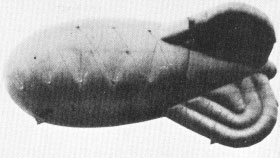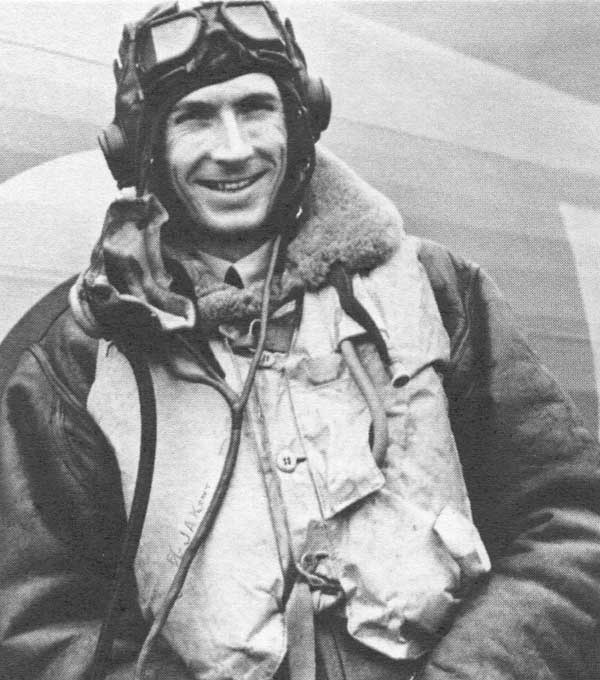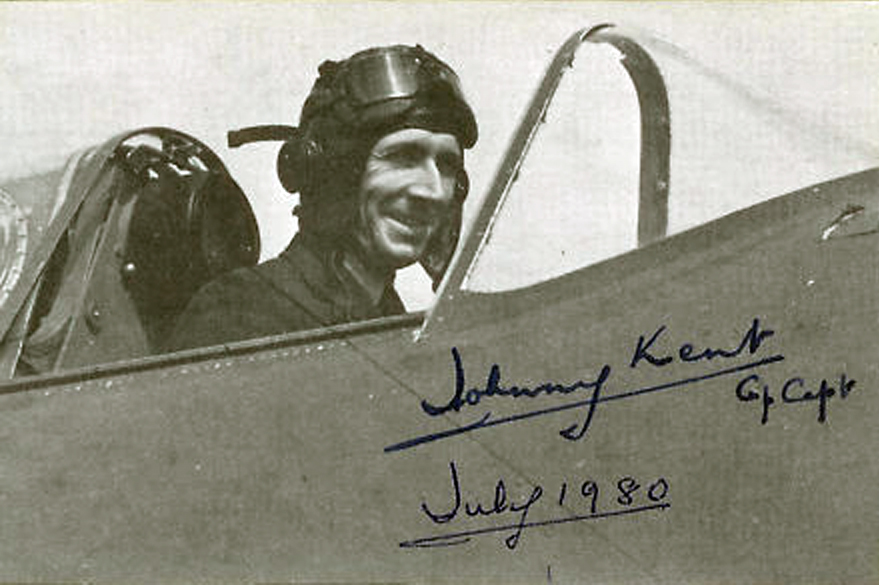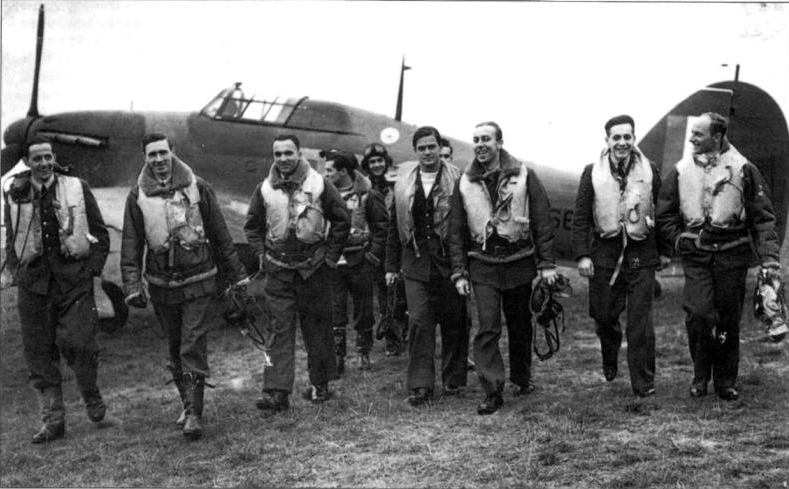 Click
for Site Directory
Click
for Site Directory37106 Group Captain John Alexander KENT, DFC and Bar,AFC , Virtuti Militaire (Polish VC)


This man was an individual who flew into the cables of barrage balloons so often that he would do it without any cause for concern. He was a famous RAF
test pilot and one of his jobs was to see how aircraft behaved on impacting a cable and have the whole event caught on film for scientific analysis.
He was born in Winnipeg on 23 June 1914 and began to fly at 16 years of age and had his own pilots licence at 17. He came to England in February 1935
and joined the Royal Air Force the following month. He was appointed Acting Pilot Officer on Probation on March 15th 1935, he was confirmed as a Pilot
Officer in 1936, a Flight Lieutenant in September 1936 and rose to Acting Squadron Leader in October 1940.
He was posted to Royal Aircraft Establishment, Farnborough as a test pilot. It was here that he undertook his research into barrage balloon cables and
their effect on aircraft.
He had
many hair raising experiences during the trials flying into cables with a Fairy
P4/34, a Wellesley, and a Battle.
He was specifically
listed in AFRO 1292/41 dated 7 November 1941 as a Canadian in the RAF who had
been decorated as of that date. Recommendation
dated 23 September 1938 (prepared by W/C M. McEntegart, Commanding Officer, Experimental Section, Royal Aeronautical Establishment) in Public
Record Office, Air 2/9315:
Flying Officer Kent has, during the last six months, made approximately 60 flights involving collision with a wire cable in connection with the special
defence experiments being carried out at this Establishment. The experiment is one which is accompanied by a considerable element of risk to the pilot
and calls for determination and a high degree of skill in piloting. Flying Officer Kent has at all times carried out these duties in a most efficient manner
. He is fully aware of the nature of the risks he is taking but has never allowed this in any way to diminish the marked willingness and zeal with which he
carries out these duties.
Also on 23 September 1938, A.H. Hall (Chief Superintendent, Royal Aeronautical Establishment) supported this with the following remarks:
I endorse the remarks above. As far as comparisons are possible I regard the work done by Flying Officer Kent as being at least as difficult and
trying as work done in previous years for which awards have been made.
On 1 November 1938 A/C Roderick Hill (Director of Technical Developments) added:
I fully endorse the recommendation of the Officer Commanding, Experimental Section and the Chief Superintendent, Royal Aeronautical
Establishment. I consider Flying Officer Kent has shown gallantry and determination in experimental flying which has not only set a fine
example, but has produced very valuable results. I consider him suitable for the award of the Air Force Cross. (Information courtesy of Air
Force Association of Canada- an excellent site indeed - http://www.airforce.ca/index.php3)
On 15th September 1939
he was promoted from Flying Officer to Flight Lieutenant.
He flew over 92 different types of aircraft many for their maiden take off and landing. He was able to learn the faults and advantages of different aircraft,
how heavy or light they were on controls, rate of climb, speed at different altitudes and oil and petrol consumption.
For each flight he would emerge with all the information clearly recorded on his writing pad.
When asked to deliberately fly into a cable he did not like the idea as this was something specifically designed to cause serious damage to an aircraft, but
never the less he still followed orders.
The first time he flew into a cable the boffins chose a very light cable, he got in a Fairey aircraft, attained the required altitude and flew straight at the
cable with a camera crew recording every moment. He said afterwards that he did not know he had flown into it as he went straight on. From that
moment on he underwent dozens of flights where the cables were increased in weight and he flew all types of British bombers into them.
Clearly each experiment was unique and the outcome unforeseen. It was only because of Sqdn Ldr Kent's superb skill and courage that he was able to
pilot the damaged plane back to a safe landing. On on occasion he sheared off three feet from the wing and landed again without any major problem.
Cables could whip around on an aircraft and might wrap around the aileron thus stopping control and if the elevator were damaged the pilot had a great
deal of work ahead to get back down safely.
One day a cable wrapped around the elevator and the tail plane and on pushing the control column forward to go down it was jammed. Using all his
strength he managed to move the column just an inch or two and he gained some control over the aircraft as it descended toward the aerodrome. The
bomber crash landed onto the runway.
On another occasion he carried a cable weighing several tons wedged into the wing of his aircraft. This sudden weight change would have sent most
bombers to the ground as indeed, this was the intention of the balloon cable. He maintained control and got ready for a landing. He was losing height due
to the large drag factor of the cable and as he came into land the dangling cable caught around some high tension electricity wires. The bomber slewed
around on one wing and stalled. Sqdn Ldr Kent opened the throttle wide open and using full power managed to pull the bomber around and level. As he
did this the aircraft fell onto the runway but the cable became detached from the high tension electricity wires. If this had not happened he would have
gone up in flames on landing. He went on to become a highly decorated war ace. Without his expertise, daring and bravery the value of barrage balloons
could never have been properly evaluated. We owe him along with many others a great debt of thanks.
Hawarden.
On 2 August 1940,
Battle of Britain.
His first combat victories came on 9 September 1940 when he shot down a ME 110
and a Ju 88. On 23 September, he destroyed a ME 109 and damaged an
Fw 58
reconnaissance aircraft while intercepting a raid over Dungeness. He shot down a
Ju 88 after a raid over
During a dogfight over the south coast of
he shot down two of the ME 109s and scored hits on another.
"Early in October 1940, this officer, when entirely alone, attacked 40 Messchersmitt ME109's and shot down two of them. He has personally destroyed
four enemy
aircraft. Flight Lieutenant
materially
contributed to it's successes. He
has proved himself a born leader."
Next he was posted to RAF Biggin Hill to take command of 92 Squadron and another highly successful group of pilots. Using the "new broom sweeps clean"
, technique, he made sure the pilots were made to follow strict orders. this proved unpopular with the some what casual attitude of the 92 Squadron
pilots
had at the time. On 1 November,
to Squadron Leader. On 24 December 1940, Kent was awarded the Polish Virtuti Militari decoration for his achievements with 303 Squadron and the
Polish pilots.

Taken in August 1940, Kent is seen here with Polish pilots from 303 Squadron.
L-R P/O M. Feric, Fl/Lt J.A.Kent, F/O B. Grzeszczak, P/O J. E. L Zumbach, P/O W. Lokuciewski, F/O Z. K. Hennerberg, P/O J. K. M. Daszewski,
and Sgt E. Szaposznikow. All appeared to have survived World War Two.
He was then posted back to Northolt as a Wing Leader in June 1941 to lead the Polish Wing of four squadrons. On 21 June 1941, during an operation
escorting
Blenheim bombers against enemy positions at
northern
Over
again as Wing Leader to command and lead the Kenley
Wing in August 1941. His first few operations over northern
proved successful, claiming ME 109s on 7 August and 16 August 1941.
a lecture tour of
On the 30th September 1941 he was sent to General duties with a permanent commissioned
rank of Flight Lieutenant.
awarded a Bar to his DFC.In June 1942,
posted to Fighter Command HQ as a Wing Commander of Training.
Two months later
in
After a posting to Air HQ as a Command Training Inspector at Air Defences East
Mediterranean, he returned to the
instructor’s course at the
Personal Staff Officer to Sholto Douglas, the Commander-in-Chief, and Military Governor of the British Zone of occupied Germany.
with many developments of military aviation. In June 1952 he was promoted from Wing Commander to Group Captain. In August 1952 he assumed
command of the RAF Station at Odiham, a fighter base operating Gloster Meteors. Subsequently he was posted as Station Commander at RAF Tangmere,
and in early 1956 accepted his final posting to RAF Newton as Station Commander.
He went on in post-war Britain to become chief Test Pilot
at Farnborough He retired from the RAF on 1 December 1956,
service with the rank of Group Captain. Johnny Kent died on 7 October 1985 at the age of 71 years. He was quite an exceptional individual, definitely
lucky, but very skilled and intuitive in his approach to flying aircraft which played a big part in his survival and success. There will never be another pilot
quite like him. Kent wrote a fantastic book on his life, "One of The Few", a highly recommended read.